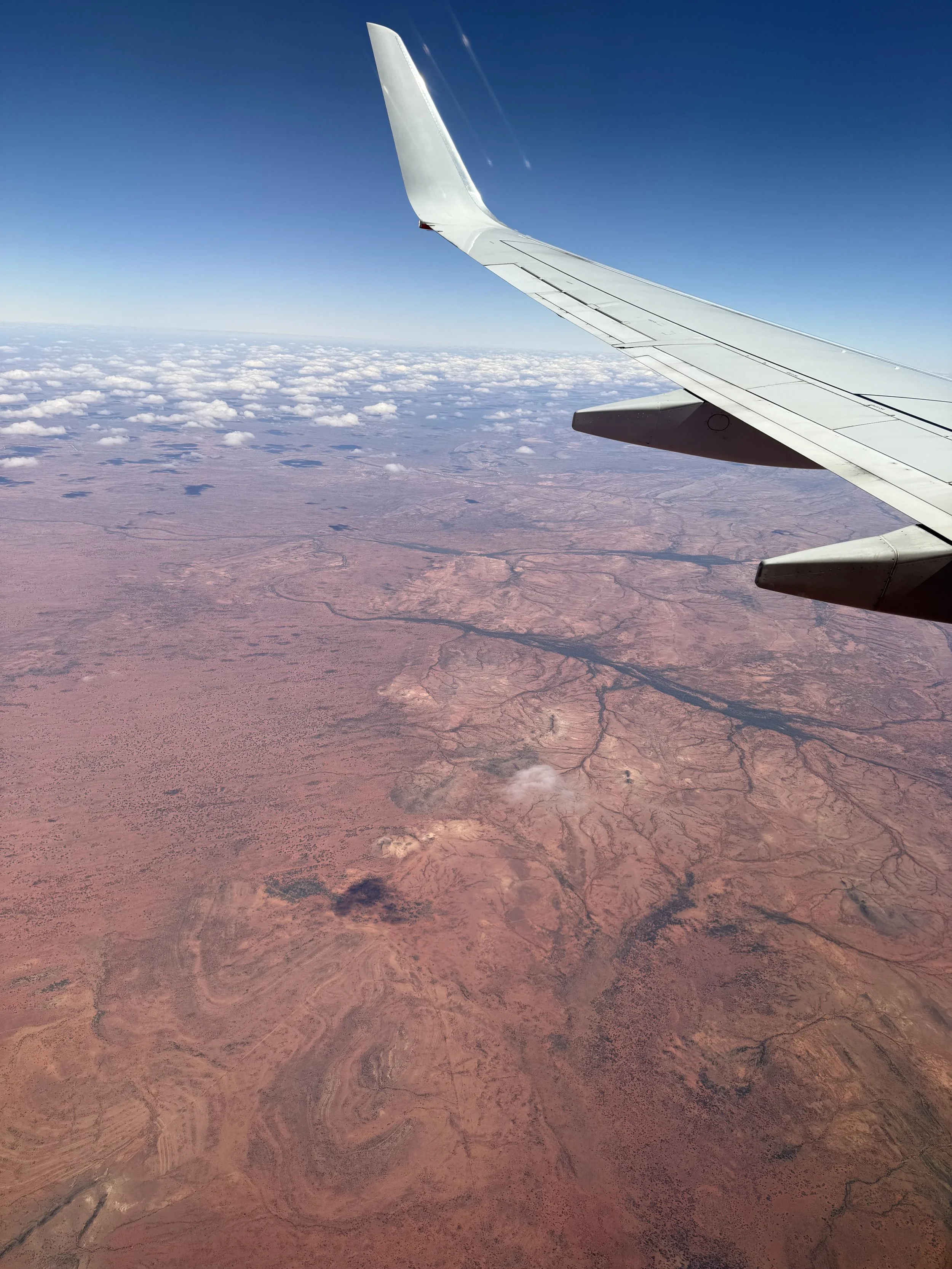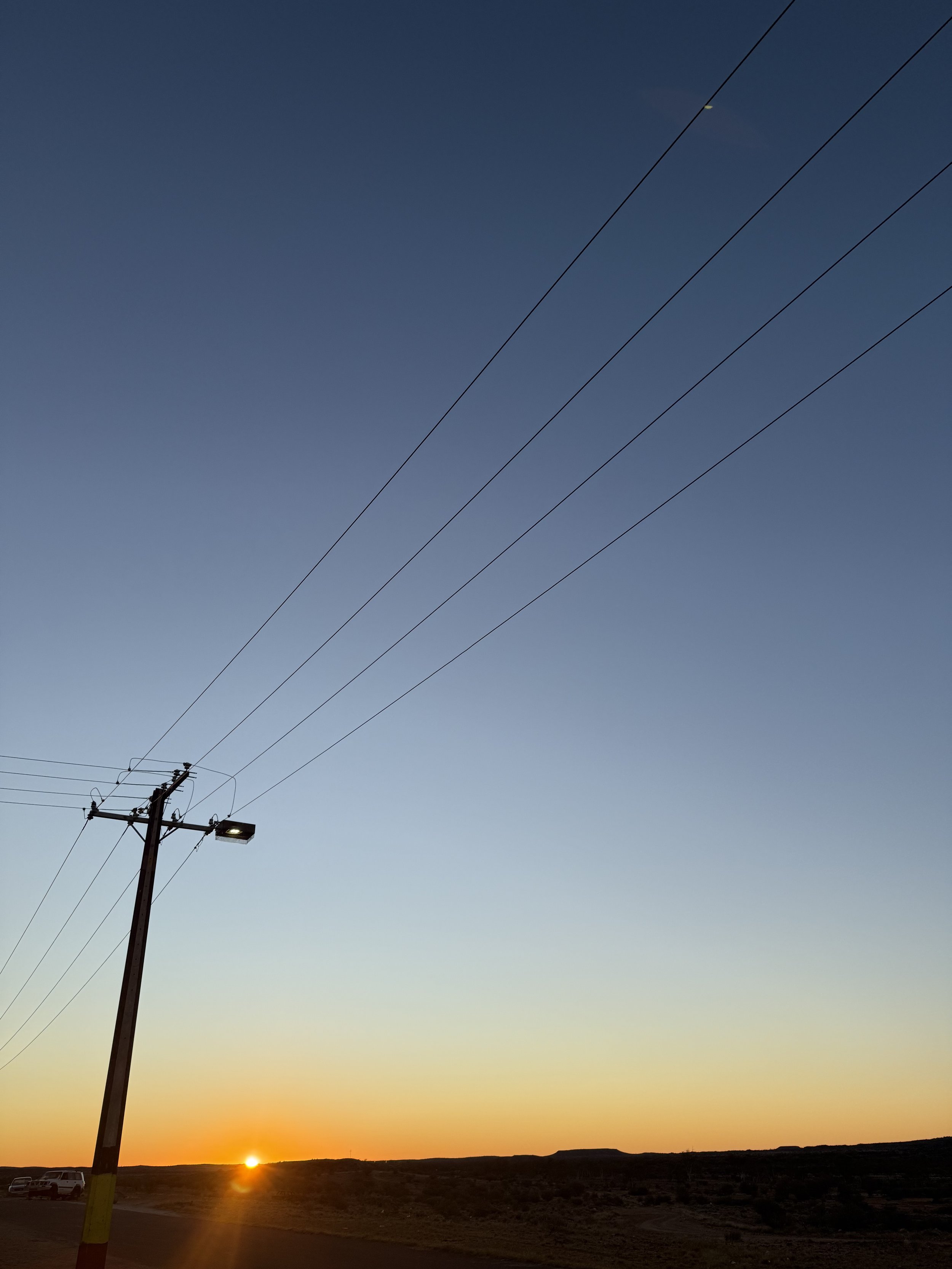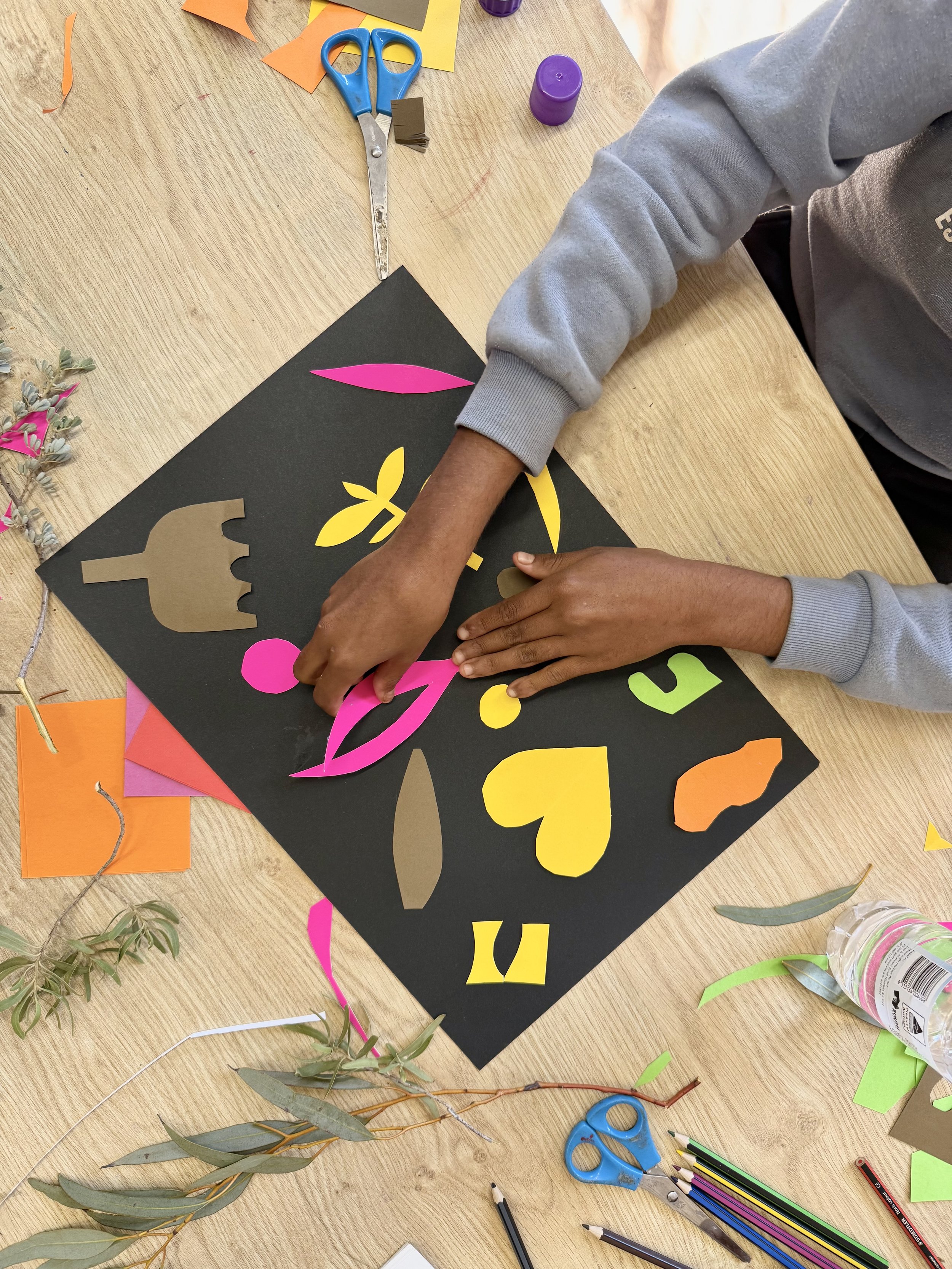An interview with Art Teacher and Wellbeing Co-ordinator, Zoe Ingoldby-Craig.
My visit to Indulkana has changed the way I see education forever. Despite my years of experience as an art teacher and through various school residencies, I have never encountered a school environment quite like this remote community.
There is so much to appreciate in Indulkana. The Art Centre is a vibrant hub of creativity, home to world-renowned artists. The school stands at the heart of the community, surrounded by red dirt, expansive skies, and a sense of quiet that offers space to breathe and reflect. But living and teaching remotely also comes with unique challenges.
For this mural project, I was invited by Zoe Ingoldby-Craig, the Art Teacher and Wellbeing Co-ordinator at Indulkana Anangu School. She has lived and worked in the community for three years. I’ve asked her to share her insights, experiences, and the realities of teaching on the APY Lands.
Teaching in Indulkana: Experience and Purpose
What first inspired you to take on a teaching role in the APY Lands?
I was drawn to the APY Lands through stories from my Nana, a powerhouse of a woman who worked as a social worker across remote communities in her youth. Her experiences planted the seed early on. Then, during the summer holidays of 2020, I received an unexpected Facebook message from the deputy principal at Amata School. Two weeks later, I had packed up and left, not knowing it would mark the beginning of a deep and enduring love for remote teaching.
Can you describe a moment that truly affirmed your purpose as a teacher in this community?
Teaching in the APY Lands is all about relationships. A moment that really affirmed my place here happened earlier this year. After a particularly emotional day, full of big feelings from both students and staff, two of our incredible Anangu Educators, Beverley and Priscilla, wrapped me in their arms and told me they could see how much I cared for their kids. At that moment, I knew all the effort, heart, and years of work had been seen. That recognition from community members meant everything.
How has your time in Indulkana shaped you, not just professionally, but personally?
My time at Indulkana has taught me three core lessons:
The importance of slowing down—everything happens on Anangu time.
The value of stepping back, listening, and making space for Anangu voices.
The power of ngapartji ngapartji—a reciprocal relationship where you give a little, and I give a little.
These lessons have shaped me not just as a teacher, but as a person.
Art, Engagement, and the Mural Project
During my visit, I saw how engaged the students were in the mural project, even those who often struggle with attention and focus. Why do you think a creative, project based learning was so effective in capturing their interest?
For our students, English is often a second or third language. Feelings of shame around low literacy or fear of making mistakes can be a real barrier to classroom engagement. The arts offer an accessible, familiar, and culturally rich form of storytelling, one students see modeled every day by their families at the art centre. The mural project allowed for outdoor learning, whole-body movement, and freedom of expression, without the pressure of being ‘right.’ That kind of learning builds confidence and connection.
What impact did the mural project have on the students, staff, and broader community?
The impact was immediate. The students’ pride was written all over their faces as they stood back and admired their work. They couldn’t wait to show their families. It wasn’t just about completing a task, it was about being seen, celebrated, and successful. The mural now stands as a public display of that success for the whole community to enjoy. It builds self-worth and reinforces the message that their voices and creativity matter.
How do you see art playing a role in wellbeing and learning for your students, especially those who may not respond to traditional classroom approaches?
Art and wellbeing are deeply connected. At Indulkana School, art is more than a subject, it’s a strategy. Students use it to regulate emotions, to process challenges, and as a way to communicate when words fall short. It helps them reflect, express, and connect, often in ways that traditional classroom settings can’t always provide.
Community, Culture and Collaboration
What does meaningful community engagement look like here? How do families and Elders contribute to the life and culture of the school?
Community engagement is at the heart of education in the APY Lands. Anangu Coordinators and Educators, who are also respected community members—shape the school’s culture in ways that non-Anangu staff simply can’t. They ensure that learning reflects community values, language, and traditions. Their presence fosters trust and continuity between school and community life.
When I visited, I was struck by the teamwork among staff, how everyone steps in when a challenge arises. How have you fostered that kind of collaborative and supportive culture at the school?
We’re incredibly fortunate to have a dedicated and resilient team at Indulkana. Working in the APY requires flexibility, empathy, and a shared sense of purpose. Everyone understands that our roles go far beyond classroom teaching, we’re here to support student wellbeing, families, and the broader community. That shared responsibility creates a culture of mutual support and collective care.
Why is it so important for new staff or visitors to first listen and observe? What kinds of things might they begin to notice or learn by doing so?
It’s easy to assume that because we’re still in Australia, the same cultural norms apply—but that’s not the case here. Coming in with solutions or assumptions can unintentionally silence Anangu voices. Listening and observing respectfully allows you to understand the subtle, non-verbal ways that knowledge is shared. Anangu may not always speak directly, but their teachings are all around you—if you're willing to slow down and pay attention.
Student Wellbeing
As both the Art Teacher and Wellbeing Co-ordinator, what are some of the biggest day-to-day challenges you face?
One of the biggest challenges is meeting the diverse and complex needs of our students. Many carry a deep fear of “getting it wrong,” which can manifest in dysregulated behaviours. Supporting emotional regulation and building trust takes time, patience, and consistent presence. Every day requires a tailored approach, there’s no one-size-fits-all here.
Many students here have experienced complex trauma, often generational. What strategies have you found most helpful in supporting them emotionally and socially?
At Indulkana School, we’re working toward student self-regulation using the Berry Street Education Model. Strategies like one-on-one check-ins, brain breaks, and “Ready to Learn” plans allow us to meet students where they are each morning. Above all, we prioritise meeting their basic needs first, only then can meaningful learning and connection take place.
What kind of support or changes would you like to see more of in the APY Lands education system?
The biggest change I’d like to see is empowering Anangu to take the lead in education. This means more opportunities for professional development, higher education pathways, and upskilling for Anangu Educators. We also need to address the ongoing lack of access to critical support services, like OT, speech therapy, NDIS, and even classroom SSOs, which puts our students at a consistent disadvantage from the start.
In your experience, what are the biggest differences between students educated in mainstream schools and those growing up in remote communities like Indulkana?
Access to opportunity is a major factor. Students in remote communities often face systemic barriers that widen the gap in education outcomes. There’s less access to enrichment activities, specialist services, and consistent infrastructure. Yet what these students bring, resilience, cultural richness, and community connection—, s profound and often underestimated.
Sustainability, Wellbeing, and Advice for Others
14. How do you manage your own wellbeing while working in a remote and often demanding environment?
Strong relationships with colleagues are essential, we lean on each other. I also set boundaries and allow myself to truly clock off after hours. Regular FaceTime calls with family and the occasional weekend trip to Alice Springs for a swim and some KFC help maintain a sense of normalcy and recharge my energy when I need it most.
What’s the most rewarding part of teaching in Indulkana?
Seeing students show up each day because school is their safe space, that’s what keeps me going. Knowing you’re helping to create an environment where they feel seen, supported, and valued is incredibly meaningful.
For teachers considering working in remote communities, what would you say to encourage them? And how can they best prepare for the shift in lifestyle, culture, and professional expectations?
Working in remote communities is a privilege. You’re given the opportunity to connect with the world’s oldest living culture and learn from First Nations leaders in a way that few people ever do. You’ll gain invaluable skills in relationship-building, behaviour management, and supporting EALD learners.
To prepare:
Don’t take yourself too seriously—be ready to laugh at your mistakes, especially when trying Pitjantjatjara!
Be a learner. Listen deeply, observe often, and approach everything with humility.
Say yes to bush days, camping trips, and local experiences. They’re as much a part of your education as the classroom.
Finally, what have your students taught you?
They’ve taught me the power of unconditional positive regard and the importance of starting each day with a fresh perspective. Even on the hardest days, there are small wins to celebrate. Those small moments of progress are what make big change possible.
My recent visit to Indulkana was an experience I’ll never forget, not only as a teacher, but as a guest welcomed into a strong and resilient community. During my time at the school, I had the privilege of working alongside students, teachers, and community members to create a mural on the external shed walls. This project wasn’t just about adding colour, it became a powerful collaboration that brought people together to create something lasting. The mural now stands as a vibrant landmark, a place of pride and celebration for the school and wider community.
Through that shared act of painting, I witnessed the heart of Indulkana: its creativity, unity, and deep sense of place. It reminded me that education here is about more than classrooms, it’s about connection, culture, and listening to others’ stories.
I cannot speak highly enough of Zoe and the staff who so passionately care for and support the children in Indulkana. For anyone considering teaching in a remote community, this experience is a powerful reminder that while the challenges are real, so too are the rewards.
Visiting Indulkana Anangu School
A unique artist in residence experience in central Australia.
WHAT IS AN ARTIST IN RESIDENCE?
Discover what an artist in residence is, the benefits for schools and communities, real examples from Australian residencies, and practical tips on finding the right artist for your program.

























